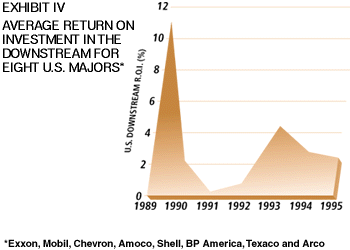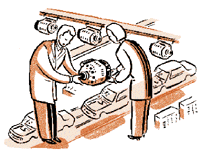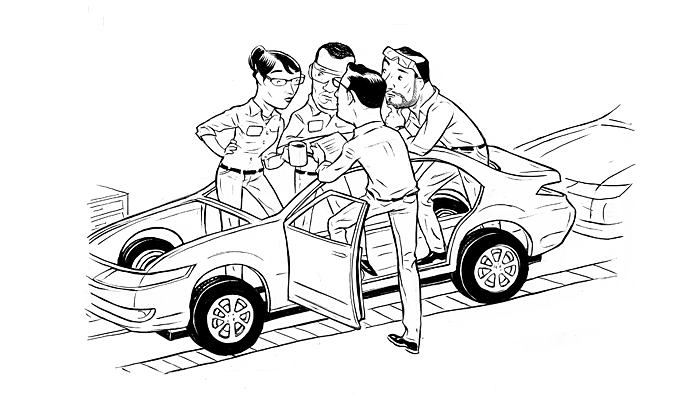Balanced Sourcing the Honda Way
 At first glance, what Honda of America does to develop its products, sustain its supply base and manage its purchasing function seems little different from what most other car makers do. But the results that Honda achieves are often remarkably superior.
At first glance, what Honda of America does to develop its products, sustain its supply base and manage its purchasing function seems little different from what most other car makers do. But the results that Honda achieves are often remarkably superior.
In 1996, for example, Honda exported more automobiles from North America than any other manufacturer, for the third straight year. That same year, the Honda Accord outsold all other cars among retail customers in the United States, setting an all-time sales record. And for the past 18 years, the company has ranked No. 1 in owner loyalty, according to R.L. Polk & Company.
So what makes Honda different? Dave Nelson, recently retired as Honda of America's senior vice president and the only non-Japanese member of the company's board, answers simply, "Everything starts with our philosophy." And he is not just paying lip service to some lacquered plaque on the wall. What he says is true: the basic philosophy on which Soichiro Honda founded the company more than 40 years ago has survived and thrived, informing and guiding every decision and action at every level in the company.
Ask Larry Jutte, plant manager at Honda's engine plant in Anna, Ohio, who can quote the Honda philosophy chapter and verse: "How do we get better results? It all goes back to our basic philosophy. Focusing on the customer. Being creative. Respecting fresh ideas. Enjoying your work. Understanding that change is good."
TURNING PHILOSOPHY INTO ACTION
For evidence of how deeply Honda's people have integrated the founder's philosophy, look no further than "Cornerstones," the bible of purchasing at Honda. The entire first chapter is devoted to explaining the Honda philosophy and the remainder to translating the overall philosophy into workable ideas for the purchasing function.
The articulation of the Honda philosophy began in 1954 when Mr. Honda set forth his concept of the "challenging spirit" in the company principle: "Maintaining an international viewpoint, we are dedicated to supplying products of the highest efficiency yet at a reasonable price for worldwide customer satisfaction."
Based on this principle, Honda pursues consistent customer satisfaction by developing a self-reliant presence in each of its major markets -- localizing sales, production, development and operations consistent with each location's customers, expectations and abilities.
Although Honda localizes by understanding and blending into the surrounding environment's culture, the company's management policy remains the same regardless of location. As "Cornerstones" affirms, the backbone of the challenging spirit articulated by Mr. Honda is the company's respect for humanity, which is reinforced by the Honda management policy:
- Proceed always with ambition and youthfulness.
- Respect sound theory, develop fresh ideas and make the most effective use of them.
- Enjoy your work and always brighten your working atmosphere.
- Strive constantly for a harmonious fiow of work.
- Be ever mindful of the value of research and endeavor.
Such statements may sound too simplistic to the skeptical outsider, but Mr. Nelson strongly defends their practical applicability: "Some people might think we're too philosophical. The practical side is that our philosophy is our long-range plan. We all know where we're going."
 A closer look at Honda's purchasing function and its business practices provides a clear understanding of how the company and its people translate philosophical thinking into concrete action. Suppliers universally describe Honda as demanding but fair -- showing it has struck the appropriate balance between cooperating with suppliers and insuring competitive pricing. The company accomplishes this balance through the development and application of three organizational capabilities -- modeling total cost, building and sustaining supplier relationships and leveraging supplier innovation.
A closer look at Honda's purchasing function and its business practices provides a clear understanding of how the company and its people translate philosophical thinking into concrete action. Suppliers universally describe Honda as demanding but fair -- showing it has struck the appropriate balance between cooperating with suppliers and insuring competitive pricing. The company accomplishes this balance through the development and application of three organizational capabilities -- modeling total cost, building and sustaining supplier relationships and leveraging supplier innovation.
An examination of how Honda has mastered these three capabilities shows clearly the company's philosophical underpinnings:
- The high expectations Honda sets for itself and its suppliers.
- The willingness to apply whatever resources are necessary to get the job done.
- The commitment to cooperation and collaboration.
- The unrelenting attention to detail.
MODELING TOTAL COST
Honda's attention to cost modeling starts with high expectations in cost management. Mr. Nelson provides an interesting example: "Imagine someone saying to purchasing three years ago, 'We have to take 30 percent of the costs out of the 1998 Accord.' It did not seem possible."
Recalling how purchasing personnel responded to the challenge by digging into the cost details, John Miller, the senior purchasing manager at Honda's plant in East Liberty, Ohio, explains: "We determined the selling price up front. Then we deducted our profit, and the result was what the cost should be. Then we broke out all those costs by component -- chassis, engine and so on -- and set targets for each area and each part. We cut up the pie and then dissected each of the pieces."
Despite the intense focus on cost, John Cope, senior purchasing manager at the Marysville, Ohio, plant, is careful to emphasize Honda's overarching customer satisfaction philosophy: "We build a quality car so we can maintain high levels of customer loyalty as well as good resale value. So when we talk about cost reductions, we don't mean just lopping 30 percent off the top. We knew that to add the features we wanted in the 1998 model and to reach our goal of keeping the price about the same, we had to add value, not infiate the price of the car."
Consistent with setting such high expectations, Honda's meticulously detailed cost-modeling process demands discipline and rigor from both the company's purchasing staff and its suppliers. Mr. Miller says, "We actually take the time to break down all the cost components ourselves."
"We want to know what the suppliers' cost structure should be," says Charles Baker, chief engineer for Honda Research and Development Americas. "We analyze their manufacturing processes to determine what their cost is so we can estimate what our cost should be. Sometimes we understand the vendors' cost structure even better than they do. Then we can calculate what a world-class supplier's cost would be, and that's our target," he says.
Honda's philosophy of frank, open communication; cooperation, and collaboration with suppliers extends even to sharing cost-modeling data. "We show our suppliers our logic in coming up with the cost, and they show us theirs," Mr. Miller says.
The cooperative approach insures that targets are achievable --and world-class. According to Rick Mayo, purchasing manager at Marysville, "the initial cost gives us a place to start negotiating the factors that contribute to cost. We have an idea of how it's got to be done, but the supplier may have a new or unique technology we don't know about."
If cost negotiations stagnate, Honda will go so far as to send in its engineers to help the supplier find a way to meet the cost target and yet maintain acceptable margins. And what if Honda's target is off the mark? "We'll change it," Mr. Nelson says. "The worst thing we could do would be not to admit a mistake."
Honda's cost-modeling process extends well beyond simply determining the cost of a part or component. It is an integrated process that takes into consideration every factor that contributes to the total cost. Mr. Mayo explains: "We know all components of cost. In the past, sales, manufacturing, purchasing and design didn't work all that closely together. But we've learned over time that to keep the customer our central focus, all areas must be closely coordinated."
According to Mr. Mayo, Honda's meticulous cost-modeling process, with its broad-based perspective, stems directly from the company's philosophy of Sangen Shugi -- the actual place, the actual part, the actual situation. "It's another thing that makes our purchasing function unique," he says. "We're located on the plant sites and in touch with manufacturing every day. We see the problems. We understand the issues. We know what the cost implications are."
Mr. Miller adds: "If we're going to make a change in a car, we have to go into the plant and get them to sign off on it. If we didn't, we might think we could save a million dollars on parts costs and then end up with two million in downtime for manufacturing."
Honda has been able to develop its methodical, precise cost-modeling capability over time in large part because of its willingness to apply the resources required to get the job done right. Early on, Honda's central Cost Research Department -- two dozen or so buyers with specialized commodity expertise -- would work in collaboration with suppliers to develop sophisticated cost models. Over the past decade, that expertise has been translated into cost tables that practically anyone can use to identify the key cost elements of a part quickly and easily. Now, rather than being a specialized individual skill, cost modeling has evolved into an organizational capability deployed throughout the company.
BUILDING AND SUSTAINING SUPPLIER RELATIONSHIPS
Honda of America has developed a network of more than 400 supplier companies throughout North America, including 180 in Ohio alone. True to Honda's philosophy of "purchase where you produce," these companies supply more than 80 percent of the parts and materials for the automobiles, motorcycles, engines and components the company manufactures. And Honda is intent on making sure that every supplier is totally in sync with the company's philosophy.
Ironically, many of Honda's supplier development programs and activities -- supplier awards programs or supplier incentives, for example -- appear very similar to those found at most other automobile manufacturers. But Mr. Nelson says the difference is in how much time, money and effort Honda invests in building and sustaining its supplier relationships.
"When we select suppliers, we expect to be with them for years," he says. "Other companies don't put the appropriate amount of resources against supplier development, so their programs aren't as well received. To score big with suppliers, you have to win their hearts."
And scoring big is precisely what Honda aims for in its supplier development program. Witness the high expectations it sets for productivity improvement. "When we go in to help a supplier, we set an overall goal of 100 percent improvement in productivity -- parts per worker per hour," Mr. Nelson explains. That "help" comes in the form of a thoroughly charted 13-week program designed and led by Honda staff members.
"We first try to identify a way to make a big impact," he continues, "like doing a major cleanup, buying lights, putting in special fioor mats, whatever it takes." (This, of course, is a natural extension of the philosophical tenet of "brightening the workplace.") He continues, "The supplier's associates start to see improvements right away. In almost every case, without prompting, everyone in the factory starts asking, 'When are you going to start improving my area?' They call it Honda-land. And everyone's smiling."
 Mr. Nelson says the 13-week program also focuses on involving the supplier's associates directly in the process. "We try to take some of their first ideas and put them into place immediately, so they see them in action right away. Then they start trying to make the program a success because it's their program."
Mr. Nelson says the 13-week program also focuses on involving the supplier's associates directly in the process. "We try to take some of their first ideas and put them into place immediately, so they see them in action right away. Then they start trying to make the program a success because it's their program."
In one example of supplier development, Honda applied its Best Practices process at Tower Automotive, a supplier of stamped parts and welded assemblies. Honda helped Tower redesign the work cell for making a B pillar, the stamped metal part between the front and back doors connecting the roof to the fioor pan.
Honda proposed using fixed-position welding stations, with simple pick-and-place robots moving the parts between stations, rather than having a sophisticated welding robot move around the part. The new cell design nearly doubled production output, from 63 parts an hour to 125. And because the fixed position of the welding gun reduced wear and tear on the welding tips, their useful life was extended to 250,000 welds from 50,000.
Consistent with its attention to detail and its focus on performance measurement, Honda uses a comprehensive program evaluation at the end of such efforts. "We always like to collect data," Mr. Nelson says. "We use them to set new goals and measure future success. Early on in supplier relationships, we can get 100 percent productivity improvements. But even in the more difficult projects, we've found we can get at least 50 percent. When you think about it, 50 percent improvement is excellent."
The Best Practices program refiects Honda's methodical, institutionalized approach to continuously improving its suppliers. But the company also demonstrates a willingness to commit significant resources toward ad hoc problem solving when needed.
Mr. Jutte, the Anna, Ohio, plant manager, makes a homespun analogy to illustrate Honda's commitment to supplier development. "If there's the possibility of a severe issue, we'll dispatch any resource to help a supplier in any way we can," he says. "It's almost like the farming communities around here. If a barn burns down, the whole community comes together. No one asks, 'Will you pay me or feed me?' Everyone just comes together. That's the way we work. We never have discussions about how we'll get paid back. It simply never comes up in discussion."
For example, one well-qualified supplier unexpectedly started to have quality and delivery problems. Honda dispatched an inside expert to assess the situation. The problem? To meet Honda's parts requirement, the supplier had been forced to nearly double its work force in a very short time. Unfortunately, the supplier lacked the management capabilities required for the larger operation. In response, Honda relocated four staff members to live and work with the supplier for 10 months to help the supplier restructure and build the company's capability to meet Honda's need.
Mr. Nelson is quick to point out that even though the cost to Honda was substantial, the company's motives for helping this supplier were hardly altruistic. "Of course, we didn't charge him for what we did," he says. "But it was also self-serving. There was plenty of benefit to be gained on both sides by making sure we kept this supplier for the long term." Suppliers see and appreciate the long-term commitment demonstrated by Honda, and this increases their willingness to make investments for Honda.
Honda's approach to building and sustaining supplier relationships extends well beyond productivity improvement programs and on-the-spot problem solving. A cooperative, collaborative relationship, by definition, is a two-way street requiring clearly expressed and understood expectations, performance measurement, attention to detail and ongoing communication.
Mr. Jutte illustrates with another homespun analogy: "Once suppliers are part of the family, discussions are open and honest about expectations for the relationship. For example, if I only talk to my son or daughter once a year about being good, I won't get a good response. But constant communication and feedback insure that my children are taking the right course.
"It's the same with suppliers. You can't just write a memo once a year. You must have ongoing communication, with clear targets for productivity, delivery and quality. We monitor these three very closely. Nothing is ambiguous. You can't work toward the same end if there's no clear definition of what we're working toward.
"My attitude with suppliers is 'Give me the opportunity to say you're doing good.' It's just as important to reward good performance as it is to recognize and correct poor performance. It's not an attitude of 'I'm watching over you because I don't trust you.' It's simply a matter of working together expediently. We get to our targets quicker if we monitor our control points and discuss our performance openly."
LEVERAGING SUPPLIER INNOVATION
To leverage the capabilities and technology of its suppliers in research and development programs, Honda has developed a process called Design In, which focuses directly on early supplier involvement. Honda will "invite" guest designers -- as many as 100 at a time -- from its outside supplier organizations to locate within Honda's facilities and work side by side with resident engineers, designers and technologists in the very early stages of a new project.
Mr. Baker believes that this process is critical to insuring that Honda will successfully integrate the best thinking and the latest technology into its new products. He says: "Our focus on building cooperative relationships requires getting the outside designers' input at the very beginning of a project, while we're still in the planning phase for the vehicle. By involving these suppliers early on, we can pick up their latest technology to make sure we're integrating it into our vehicle."
On major strategic systems, where the technology is evolving and the cost implications are large, Honda develops technology road maps and shares them with suppliers. Mr. Baker says: "We use the technology road map to show our critical suppliers the direction we're going in and to ask them to help us. We set high expectations for focused and targeted project management. And, because our development schedule is very compressed, we expect suppliers to make their latest technology available to us and to keep up with us to get the final product to market." Reaffirming Honda's central focus on the customer, Mr. Baker says, "We're very much a product organization, focused on making the product better for the customers. We work best with suppliers who view product development as a strategic process -- suppliers who can target and develop technology and apply it in sync with us."
Honda has also had great success in leveraging its suppliers in removing cost during new product development. The dramatic cost reduction goal for the 1998 Accord offers a good example of Honda's focus on collaboration in leveraging suppliers in innovation.
Mr. Nelson recalls: "The first thing we did was compile a big list of every possible way we could remove costs from the 1998 Accord; most of them, in fact, came from our suppliers' work with purchasing and engineering. We studied each idea, prioritized them according to their likelihood of success and then just started focusing our work on developing them."
Most of the cost-cutting efforts centered on the design aspects of the new model. Suppliers played a major role here, too. "We took competitors' cars apart," Mr. Miller says, "and then asked our suppliers to tell us about their components and parts: what's better, what's worse, what's costly, what's not. We did this in the U.S. and in Japan over the span of two years."
By the time the 1994 model hit the market, Honda had already determined what the 1998 model was going to be, its cost and its price. Mr. Nelson says, "Since the front end of the process took place about two and a half years before product launch, about 10 percent of the savings from the 1998 Accord splashed over into the 1996 Civic. And it showed in our profitability."
Honda's success in setting high expectations for its suppliers and then working cooperatively to help the suppliers meet them has earned the company's purchasing function national respect and recognition. Purchasing Magazine says: "Kudos to Honda for its supplier development! Together purchasing and its suppliers work to reduce costs, improve quality and develop technology -- a system that has earned Honda the Medal of Professional Excellence."
INVESTING IN PEOPLE
The nature of what Honda does in terms of cost modeling, supplier development and leveraging of supplier innovation really does not differ greatly from what other successful companies do. So why does Honda get better results?
The first answer on any Honda executive's list of "whys" would probably be "people." But is it reasonable to assume that Honda gets the best of the available crop of employees and all other companies settle for the rest? A more rational explanation is that Honda's people are no more exceptional than other companies'; Honda simply expects more from them. And it invests in them to make sure that they perform to its high expectations.
"To move up in this company," Mr. Miller says, "you're expected to have well-rounded knowledge and experience. And Honda is good at rounding people out. They don't always keep you in an area where you're an expert. They want you to be challenged -- a little uncomfortable. So you'll have to stretch to reach even higher levels of performance."
Respect for the individual and a de-emphasis on hierarchical differences among Honda workers -- all employees from the executive suite to the production line wear identical white uniforms, park in the same parking lot and eat in the same cafeteria -- also contribute to a highly motivated, involved work force. "I'm given a lot of respect every day at Honda," says Elizabeth Geboy, who works at the East Liberty auto plant. "I'm listened to when I give a suggestion or an idea. That's the basis for respect."
Mr. Jutte cites Honda's atmosphere of open communication as a primary reason that every individual has the confidence to step forward and contribute. "Anybody can make a suggestion about changing anything," he notes. "There's a strong undercurrent to make continuous improvement."
According to Darrell Hoy of the East Liberty plant, "Associates who work on the line every day are the experts in how we build our products. It's rewarding to see an idea implemented by the associate on the line and watch it have a very big impact in terms of reducing costs or improving quality."
But Mr. Jutte points out that there is another side to contributing as an individual: "You really can't take sole ownership of an idea you had or protect something you did. You have to stay open to improvements on your own ideas, too, to bring out the best and build total team ownership. But it's still our people who bring forth some of our best new ideas. That's why we talk to them, listen to them and funnel their ideas into improving equipment, processes and systems."
 Honda also invests its resources in making sure its people get the training and development opportunities they need to succeed, as it did with its initial "investment" of 50 seasoned experts who were sent from Japan to the United States to teach, advise, consult and transfer their knowledge and skills to their American counterparts. Since Honda of America has now developed its own cadre of experts, most of the original Japanese associates have returned to Japan or other Honda sites throughout the world.
Honda also invests its resources in making sure its people get the training and development opportunities they need to succeed, as it did with its initial "investment" of 50 seasoned experts who were sent from Japan to the United States to teach, advise, consult and transfer their knowledge and skills to their American counterparts. Since Honda of America has now developed its own cadre of experts, most of the original Japanese associates have returned to Japan or other Honda sites throughout the world.
And the company guards its investment in people closely. For example, Honda has a no-layoff policy. There has never been a layoff in the history of Honda of America.
Even workers who have chosen to leave Honda for another employer are highly valued. For example, those who have left the purchasing function are referred to as Honda "purchasing alumni," and efforts are made to remain in communication with them, to sustain amicable relationships and possibly even to bring them back if the time and circumstances are right.
CONCLUSION
Mr. Nelson has good reason to take pride in Honda of America's superior performance and is justifiably optimistic about the company's future. He is more guarded, however, in his assessment of other American companies' willingness and resolve to set aggressive improvement targets and to commit the resources necessary to achieve them.
"Most of our large companies in North America have the same capability that Honda has to take costs out," he says. "With the hundreds of billions of dollars' worth of purchases we all make, there's easily 25 to 30 percent cost to be taken out. That ought to be an incentive for anyone to recognize the opportunity, grab hold of it and integrate it into their company. Many simply don't have the heart for this sort of thing."
In Honda's purchasing guidebook, "Cornerstones," the concepts and ideas expressed in purchasing's underlying philosophy may seem like basic common sense, but attention to the basics and to the challenging spirit is what sets Honda apart from other companies. Certainly, as a philosophy-led company, Honda stands apart from most United States-based companies. But the company's ability to turn that philosophy into action is where the difference meets the bottom line. It is the high expectations Honda sets for itself and its suppliers, its willingness to apply whatever resources are necessary to get the job done, its commitment to cooperation and collaboration, and its unrelenting attention to detail that have put Honda and its purchasing function among the very few that have fully embraced and applied the Balanced Sourcing model. ![]()
| Authors
Timothy M. Laseter, laseter_timothy@bah.com Tim Laseter is a vice president with Booz Allen Hamilton in McLean, Va. He has 14 years of experience building organizational capabilities in sourcing, supply chain management, and e-business strategy in a variety of industries. |


